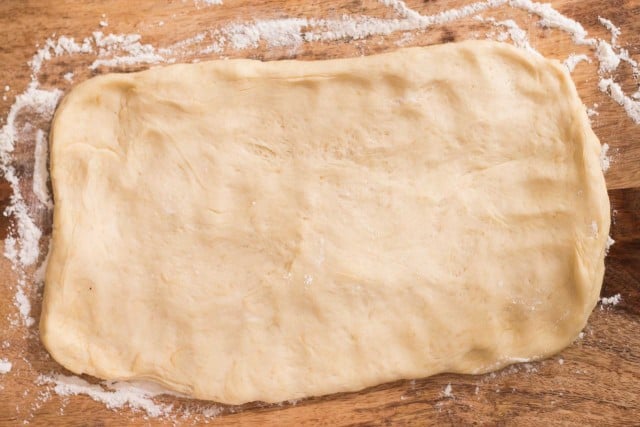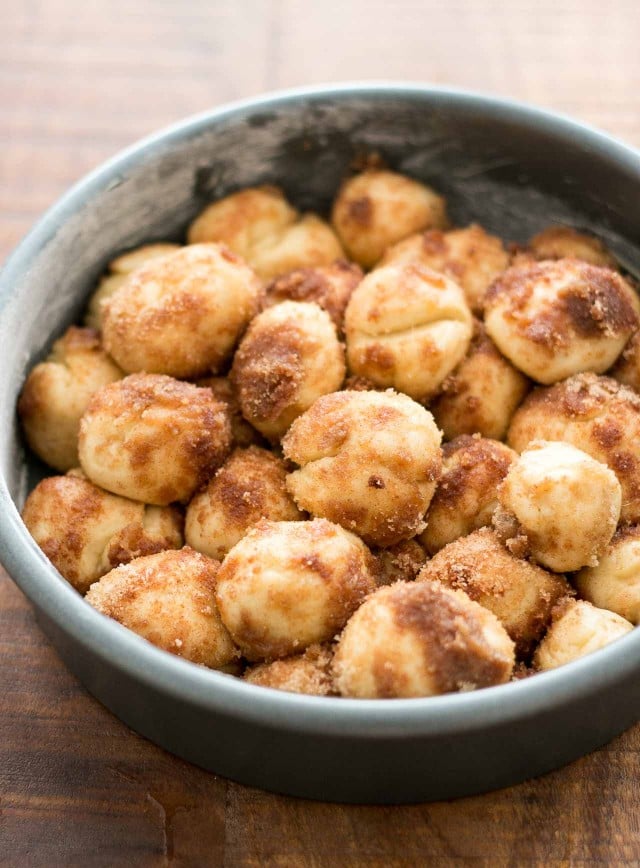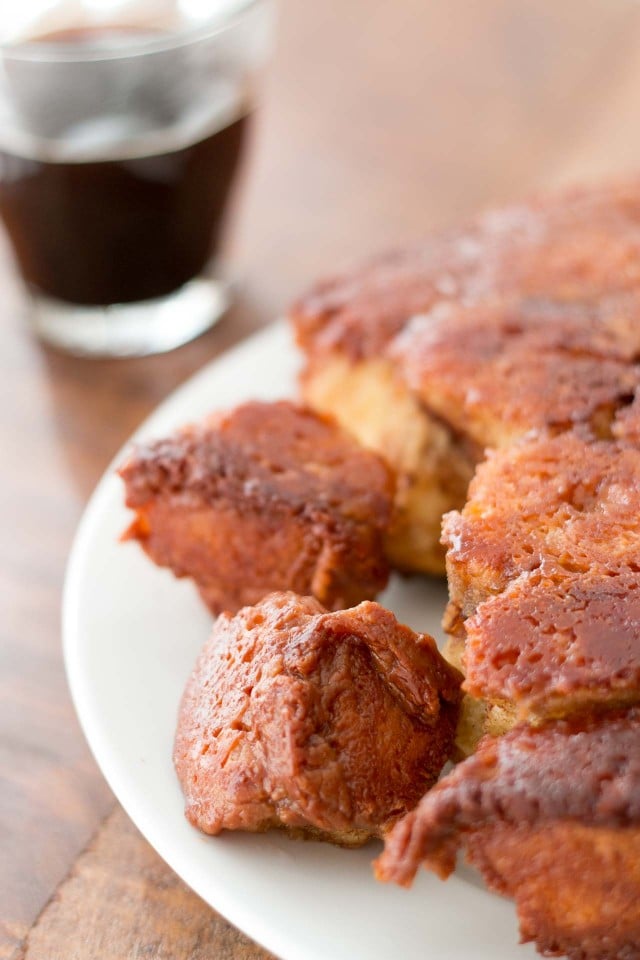Low Sugar Monkey Bread

I’m never quite sure what to say when people ask if they can reduce sugar in a recipe. My inclination is to say Non! right off the bat. Not because I’m in France, and it’s reflexive, but because when I test or develop a recipe, I get the sugar balance just to where I like it before it goes into a book or on the blog. It’s like asking someone if you need to wear shoes. It’s my preference, but if you don’t want to use the quantities given – well, be my guest! I just always follow that up with a note that people might not be happy with the results. Ditto with making other substitutions: If I haven’t personally tried it, I can’t recommend it.
I don’t mean to be Déborah Downer, but I don’t know how it’s going to turn out so don’t want to give something the okay unless I know people will be happy with the result. Since sugar makes things moister, as well as sweeter, changing the measurement or substituting an ingredient in a recipe can result in a dry cake or tough batch of cookies. (It’s also a conserving agent so treats won’t last as long…although I don’t have that trouble at my house.)
However when Baking with Less Sugar by Joanne Chang of the famed Flour Bakery in Boston landed on my kitchen counter, I was intrigued because it was nice to flip through the pages and see what is obviously a well-tested collection of recipes from a pastry chef and bakery owner who I admire very much, where the sugar is reduced or replaced by another sweetener. (A good omen is when an author discusses in the headnote how they came up with the recipe, and what kind of testing went into it, so you can be reasonably confident the author tested it thoroughly.) Leafing through the book had me excited to give one of the recipes a try, and this Monkey Bread stood out.
Monkey Bread is traditionally is slathered with a lot of butter and sugar. And sometimes people pour sugary icing all over it, too. But caramel is one of those things where a little can go a long way, and Joanne manipulated the ingredients to find the perfect balance of flavors and sweetness without going overboard.
These aren’t diet recipes, but recipes where the sugar has been reduced to the point where flavor isn’t sacrificed. Joanne said this Monkey Bread was “crazy delicious,” and after I pulled off that first puff of the glazed dough, still warm from the oven, I had to agree.
Speaking of people “going rogue” with recipes, I speak from experience because the first time I made it (Yes – I talk about the goofs, to let you know I made it a couple of times), I didn’t have an 8-inch (20cm) cake pan so used a 9-inch (23cm) springform. Even though I wrapped the pan very well, it leaked. Fortunately I was wise enough to put it on a parchment lined baking sheet first. Otherwise I would have still been cleaning up that mess rather than sharing the recipe with you. The larger cake pan also didn’t promote caramelization the way the more compact pan did that I used on the second round, the one called for in the recipe, when it came out perfectly. So try to find an 8-inch (20cm) cake pan if you can. I did take liberties and swapped out light brown sugar for the white sugar for rolling the balls of dough, which worked really well.
The Monkey Bread was really lovely and I didn’t feel as guilty as I usually do when I’m pulling hunks and forkfuls of cake with this recipe. The caramel bath the dough bakes in takes you right to the edge, with just the right amount of sweetness, without going overboard.
The individual bites tastes like mini sticky buns without the overwhelming tooth-aching sweetness that most have. I also liked that I could have one small bite at a time, plucking off a bit of yeasty dough with just the right amount of sticky caramel attached, rather than dealing with a jumbo whole cake, without clearly marked stopping points. It made a great accompaniment to my afternoon coffee, which I took without sugar.
Low Sugar Monkey Bread
For the bread
- 3/4 cup (180g) whole milk, ever-so-slightly warmed, or as Joanne says “at body temperature”
- 1 teaspoon sugar or honey
- 1/2 teaspoon active dry yeast or 3g fresh cake yeast
- 2 cup (280g) flour
- 1 teaspoon kosher or fine sea salt
- 3 tablespoons unsalted or salted butter, at room temperature
- 1 large egg yolk
For the sauce
- 1/2 cup (115g) unsalted butter, melted
- 1/2 cup (90g) light brown sugar or granulated sugar (100g)
- 2 teaspoons ground cinnamon
- 1/4 teaspoon kosher or fine sea salt
- 2/3 cup (160g) heavy cream
- To make the dough, in the bowl of a stand mixer fitted with the paddle or dough hook (or if making by hand, in a large bowl) combine the milk, sugar or honey, and yeast. (If using fresh yeast, crumble it before adding it.) Let sit a few minutes until it starts to bubble a bit. Add the flour and salt and on medium-low speed, mix the dough until it just starts to come together, which will take less than a minute. When it is still rough looking, add the butter and egg yolk. Mix or knead the dough in the bowl for 2 to 3 minutes, until it comes together and is relatively smooth, but still slightly sticky.
- Cover the bowl with a kitchen towel and let rise until doubled in a warm place, which will take about 2 hours.
- Butter an 8-inch pan with sides at least 2 inches high (20x5cm). On a lightly floured counter, stretch the dough until it’s a 12″x4″ rectangle. (30x10cm). Use a chef’s knife or pizza wheel to cut the dough lengthwise into four strips, then cut the dough vertically so you’ve got a total of 32 pieces. (Refer to the picture in the post.) Have the melted butter in one bowl, and the brown or granulated sugar, cinnamon, and salt in another.
- Working with a few at a time, roll a couple of dough pieces into rounds. Dip each into the melted butter, shaking off the excess, roll it in the sugar mixture, then place it in the prepared cake pan, leaving some space between them. Don’t crowd them in the pan as they need room to rise, again. Continue with all the pieces of the dough, stacking them up when the bottom is completed. Reserve the remaining sugar and butter.
- Cover with a kitchen towel and let rise in a warm place until doubled, about 1 to 1 1/2 hours. About 15 minutes before they are fully risen, preheat the oven to 350ºF (180º).
- Stir the remaining sugar and butter (rewarmed) from dipping the dough rounds into the cream and pour the mixture over the dough in the pan. (Mine didn’t do it but if you’re concerned the cake may bubble up and over the sides of the pan, you can bake the cake on a baking sheet lined with foil or parchment paper.) Bake the monkey bread until the top is golden brown. If using brown sugar, it will take about 30 to 35 minutes. If using granulated sugar, 45 to 50 minutes. Remove from oven and let rest 5 minutes, then run a knife around the outer edge of the bread and invert on a serving plate. If any sauce remains stuck in the pan, remove it with a spatula and spread it over the monkey bread.
























